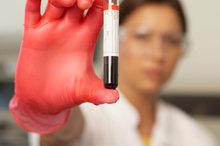Can Iron Deficiency Link to Liver Problems?
The body needs iron to form hemoglobin -- a protein in red blood cells that carries oxygen from the lungs to the body’s tissues. About one-third of iron absorbed into the body is stored in the liver, spleen and bone marrow in compounds known as ferritin and hemosiderin, according to the University of Maryland Medical Center. Although iron deficiency can lead to health problems, iron overload is more likely to increase the risk of infection and cause damage to the liver.
Iron Metabolism
Iron, which is absorbed into the body through cells in the intestines, is present in a wide variety of foods. A protein known as ferritin receives iron from the gastrointestinal tract and then stores it until the body needs more iron. At that point, ferritin releases iron to the protein transferrin, which transports iron to the blood. Both iron and transferrin are used to produce hemoglobin, which the body stores in the liver, spleen and bone marrow.
- Iron, which is absorbed into the body through cells in the intestines, is present in a wide variety of foods.
- Both iron and transferrin are used to produce hemoglobin, which the body stores in the liver, spleen and bone marrow.
Iron Deficiency vs. Iron Overload
How Long Does Iron Stay in Your System?
Learn More
Signs that you may have an iron deficiency include swelling of the tongue, mouth ulcers and brittle nails. Fatigue and pale skin are other common symptoms of anemia -- a condition where your body has fewer than the normal number of red blood cells. Restless legs syndrome, bloody stools, heavy menstruation, frequent infections and an enlarged spleen are more serious symptoms of iron-deficiency anemia. Symptoms of hemochromatosis, or iron overload, can be similar to symptoms of iron deficiency. Amenorrhea, fatigue, headache, irritability and enlarged liver are common symptoms of the disease. Darkening of skin pigmentation is another sign of hemochromatosis.
- Signs that you may have an iron deficiency include swelling of the tongue, mouth ulcers and brittle nails.
- Restless legs syndrome, bloody stools, heavy menstruation, frequent infections and an enlarged spleen are more serious symptoms of iron-deficiency anemia.
Hemochromatosis and the Body's Organs
Hemochromatosis is a disease where the intestines absorb too much iron, which accumulates in the body. This excess of iron collects in the organs that store iron and in the pituitary gland, testicles, heart muscle, pancreas and joints. Elevated levels of iron in the blood increases the risk for diabetes, arthritis and heart or other organ failure. Too much iron in the body can eventually lead to sexual dysfunction or organ damage. The liver, heart and pancreas are particularly susceptible, reports the National Heart Lung and Blood Institute 1. When iron builds up in the liver, scarring of the liver known as cirrhosis occurs. Iron overload also increases a person’s risk of developing liver cancer.
- Hemochromatosis is a disease where the intestines absorb too much iron, which accumulates in the body.
- Elevated levels of iron in the blood increases the risk for diabetes, arthritis and heart or other organ failure.
Diagnosis
Side Effects of Eating Too Much Iron
Learn More
Individuals usually experience no symptoms during the early stages of hemochromatosis. High iron levels are often detected during routine blood testing. Many times a doctor diagnoses the disease when testing to rule out other medical conditions. Although there are several types of blood tests that are used to identify iron levels in the body, a liver biopsy is the most accurate test for diagnosing hemochromatosis. The test measures a sample of liver tissue for iron content. Liver biopsy can also identify cirrhosis and other liver diseases which can be made worse by too much iron.
- Individuals usually experience no symptoms during the early stages of hemochromatosis.
- Although there are several types of blood tests that are used to identify iron levels in the body, a liver biopsy is the most accurate test for diagnosing hemochromatosis.
Related Articles
References
- National Heart Lung and Blood Institute: Hemochromatosis
- University of Utah: Diseases of Iron Metabolism
- McDowell LA, Sticco KL. Iron overload. StatPearls. Updated February 21, 2019.
- Cleveland Clinic. Hemochromatosis: Diagnosis and tests. Updated May 11, 2016.
- Cleveland Clinic. Hemochromastosis: Management and treatment. Updated May 11, 2016.
- Porter JL, Rawla P. Hemochromatosis. StatPearls. Updated June 4, 2019.
- Geissler C, Singh M. Iron, meat and health. Nutrients. 2011;3(3):283–316. doi:10.3390/nu3030283
- Girelli D, Ugolini S, Busti F, Marchi G, Castagna A. Modern iron replacement therapy: clinical and pathophysiological insights. Int J Hematol. 2018;107(1):16-30. doi:10.1007/s12185-017-2373-3
- Gao C, Li L, Chen B, et al. Clinical outcomes of transfusion-associated iron overload in patients with refractory chronic anemia. Patient Prefer Adherence. 2014;8:513–517. Published 2014 Apr 22. doi:10.2147/PPA.S56238
- Hamilton JPA. Secondary iron overload. Merck Manual Professional Version. Updated January, 2019.
- Kaiser Permanente. Ferritin. Updated March 28, 2019.
- Hamilton JPA. Hereditary hemochromatosis. Merck Manual Professional Version. Updated January, 2019.
- Brittenham GM. Iron-chelating therapy for transfusional iron overload. N Engl J Med. 2011;364(2):146–156. doi:10.1056/NEJMct1004810
Writer Bio
Amber Keefer has more than 25 years of experience working in the fields of human services and health care administration. Writing professionally since 1997, she has written articles covering business and finance, health, fitness, parenting and senior living issues for both print and online publications. Keefer holds a B.A. from Bloomsburg University of Pennsylvania and an M.B.A. in health care management from Baker College.









